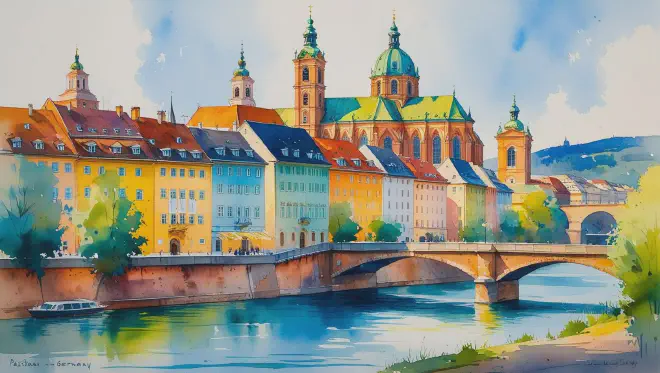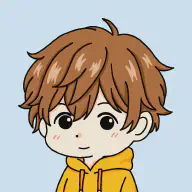Introduction: A City Born from Three Waters
Passau. There’s something about the way this name rolls off the tongue that warms the heart. Nestled in southeastern Germany near the Austrian border, this intimate city sits at the confluence of three rivers—the Danube, Inn, and Ilz. Known as the “City of Three Rivers” (Dreiflüssestadt), Passau is both a natural miracle shaped by flowing waters and a cultural treasure trove woven from over a thousand years of history.
Baroque buildings line the riverbanks while the green dome of St. Stephen’s Cathedral reaches skyward as the city’s defining symbol. As a episcopal seat that has flourished since medieval times, this city still bears the rich traces of its Austro-Hungarian past. Walking along its cobblestone lanes, time seems to pause, caught in an eternal moment of quiet beauty. It was precisely this serene magnificence that drew me to plan my journey to Passau.

Day 1: Destiny at the Meeting of Waters
The train from Munich took about two and a half hours, and as I gazed out at the verdant Bavarian countryside rolling past my window, I found myself at Passau Central Station. Stepping onto the platform, stone buildings and church spires immediately greeted my eyes. The air was crisp and carried a scent that felt somehow familiar and welcoming.
My morning began with a walk toward the city center. The fifteen-minute stroll from the station to the old town took me along the Danube promenade, where I admired the colorful houses of the Oberhaus district across the water. The buildings’ reflections shimmered on the river’s surface like a watercolor painting come to life.
I reached St. Stephen’s Cathedral just as morning mass was ending. Pushing open the heavy doors and stepping inside, I could still feel the lingering resonance of the world’s largest church organ hanging in the air. The harmony created by 17,974 pipes possessed an otherworldly power that seemed to transport one’s soul to another dimension. The interior, adorned with baroque decorations, was a mystical space where light and shadow danced together, leaving me breathless.
For lunch, I dined at “Zur Blauen Donau,” a venerable restaurant near the cathedral. I ordered their signature dish, Sauerbraten—marinated pot roast served with red cabbage and Knödel dumplings. The meat was tender, the sweet-and-sour sauce exquisite, and the pairing with beer was perfection. A local elderly couple at the neighboring table smiled warmly at my fumbling German, their kindness touching my heart.
The afternoon brought me to the three-river confluence point. Dreiflüsseeck, at the eastern tip of the old town, is truly Passau’s most symbolic location. To my left flowed the blue Danube, to my right the green Inn, and beneath my feet ran the brown Ilz. Three different colors of water becoming one—I sat on a bench and watched this moment intently. The varying hues seemed to tell stories of the different lands each river had traveled through, carrying memories in their currents.
Evening found me climbing up to Veste Oberhaus, the 13th-century fortress that offers a panoramic view of the entire city. The red-tiled roofs bathed in golden sunlight, the river surface reflecting amber light, and the distant Alpine ridges created a scene so painterly beautiful that my camera couldn’t rest.
As night fell, I savored local Riesling at “Alte Reben,” a wine bar in the old town. The crisp, dry wine soothed the day’s fatigue perfectly. Hans, the bartender, was born and raised in Passau, and he spoke passionately about the city’s history. “This city was born from the power of water and nurtured by water’s blessings,” he said—words that resonated deeply within me.
From my hotel room window, I could see St. Stephen’s Cathedral illuminated against the night sky. Passau wrapped in evening silence revealed a completely different face than during the day. The gentle murmur of the rivers served as a lullaby, drawing me into peaceful sleep.
Day 2: Embracing Culture Amid Forests and Ancient Castles
Morning arrived with the hotel’s breakfast room offering local honey, cheese, and fresh-baked pretzels. Outside my window, dawn mist rose from the Danube, wrapping the entire city in a dreamy white veil. This sight alone filled me with anticipation for what promised to be an extraordinary day.
The morning was spent on a Danube cruise, a two-hour journey upstream to Engelhartszell and back. The scenery from the boat was entirely different from what I’d seen on land. Medieval castle ruins and monasteries appeared one after another along both banks, making me feel as though I was traveling through a fairy tale world. Particularly striking was Wörth Castle, perched atop a rocky hill. This 12th-century structure emanated a dignity that transcended the flow of time.
After returning from the cruise, I visited the Passau City Museum. Located in the former episcopal residence, this museum contains the essence of the city’s 2,000-year history. From Roman artifacts to medieval religious art to 19th-century civic life, everything was thoughtfully displayed. What fascinated me most was the exhibition documenting the history of floods caused by the three-river confluence. I could sense the wisdom and determination of people who had learned to coexist with both nature’s bounty and its threats.
Lunch took me to “Zum Grünen Baum,” a small Gasthof along the Inn River. This restaurant specializes in local river fish, and I ordered trout Müller-style caught from the Inn. Pan-fried in butter and almonds until golden, the fish was perfectly flaky, with lemon providing an exquisite accent. The accompanying boiled potatoes and spinach were prepared with gentle seasoning that honored the natural flavors.
My afternoon adventure led me slightly outside the city to Mariahilf Pilgrimage Church. About thirty minutes by car from Passau, this beautiful baroque church stands atop a hill overlooking the Danube. The ceiling frescoes inside were breathtakingly beautiful, with an exquisite use of light. What moved me most was the view from the church. The Danube meandered gently below while verdant hills stretched to the horizon. Gazing upon this landscape, I felt simultaneously the smallness of human endeavors and the magnificence of nature.
On the return journey, I stopped at a small village bakery where I met Maria, an elderly woman making traditional Apfelstrudel. This pastry, created by wrapping thin dough around apples and cinnamon before baking, had been her craft for over fifty years. The fresh-baked slice she offered me combined the fragrance of butter with the sweet-tart flavor of apples, truly embodying the warmth of home.
Back in Passau by evening, I strolled leisurely through the old town. Cobblestone alleys were lined with antique shops and handicraft stores. In one of them, I purchased a small plate decorated with blue Danube motifs, crafted by a local potter. The shop owner, Gerhard, explained that “this blue captures the most beautiful moment of the Danube’s color.”
Night brought me to “Augustiner Bräu,” a beer garden where locals gathered. Under the chestnut trees in the courtyard, I shared drinks with residents while communicating through a mixture of German, English, and gestures. Markus, a university student sitting beside me, was studying history at the University of Passau and enthusiastically explained the city’s medieval architecture. Feeling the deep love this young generation held for their hometown warmed my heart.
Day 3: A Promise Held Close as Morning Brings Farewell
On my final morning, I woke earlier than usual. Walking through the still-dim streets, I returned once more to the three-river confluence. The water’s surface, wrapped in morning mist, showed yet another expression from the day before. In the perfect silence, with only the sound of flowing water, I felt nature’s sacred presence anew. After standing there for thirty minutes, the morning sun gradually began illuminating the river surface, and all three rivers gleamed like gold.
After breakfast, I used my remaining time to attend an organ concert at St. Stephen’s Cathedral. These daily thirty-minute performances at noon allow visitors to experience the true power of the world’s largest church organ. As Bach’s “Toccata and Fugue in D minor” filled the space, the entire cathedral seemed to become a musical instrument itself. I could feel the power of music and the magnificence of human creativity with my entire being.
Late morning took me to the Passau Glass Museum, which houses one of the world’s largest collections of Bohemian glass. Colorful glass artworks were displayed throughout, and I was captivated by the beauty created through light refraction. Particularly impressive was a 19th-century Biedermeier-style glass set that spoke to the rich lifestyle of citizens from that era.
For lunch, I returned to “Zur Blauen Donau” from my first day, this time trying Schweinebraten—roast pork knuckle. The meat, with its crackling crispy skin and juicy interior, paired perfectly with sauerkraut. Even at the same restaurant, trying a different dish brought new discoveries.
The afternoon was spent on final shopping and one last city walk. I purchased “Passauer Senf” (Passau mustard), a local specialty, and “Klosterlikör,” liqueur made at a monastery. Both products carried long traditions and would surely evoke memories of Passau long after returning home.
As evening approached and I packed my belongings, I reflected on these three days and two nights. While Passau isn’t a large city, its intimate size allowed me to explore every corner and feel close to the local people. Like the three rivers flowing together, different cultures and eras harmoniously coexisted here. The time spent in this place felt as though a new river had been born within my own soul.
On my way to the station, I stopped one last time to gaze at the Danube. The river continued flowing quietly, unchanged. Whether I was there or not, this beautiful landscape would continue to exist. Yet surely, the memory of Passau’s rivers would flow eternally within my heart.
As the train departed the station, I caught sight of St. Stephen’s Cathedral’s green dome through the window and gave it a small wave. “I will definitely return,” I whispered to myself, a promise held close to my heart.
Epilogue: What Feels Real Despite Being Imagined
This journey exists only in imagination. I never actually walked Passau’s cobblestones or watched the sunset at the three-river confluence. Yet having traveled to this city through words, vivid memories remain in my heart as if I had truly been there.
Perhaps Passau’s charm lies in its intimate scale—a place where connections between people, between humanity and nature, and between past and present can be felt in ways impossible in large cities. Like the three rivers flowing together, a traveler’s heart naturally becomes part of the city itself.
Even when imaginary, a journey crafted with genuine care leaves something real within us—an invisible treasure more valuable than photographs or souvenirs. Though my imaginary journey to Passau has ended, the Danube continues flowing quietly through my heart.
And someday, when I truly visit Passau, this imagined memory will merge with real experience to create even deeper emotion. Perhaps that moment when the boundary between imagination and reality blurs is the true essence of travel itself.

